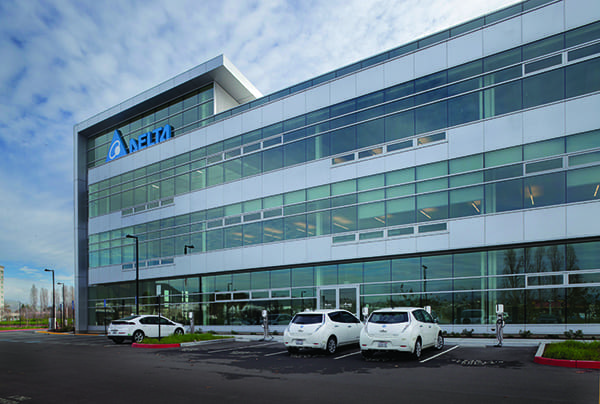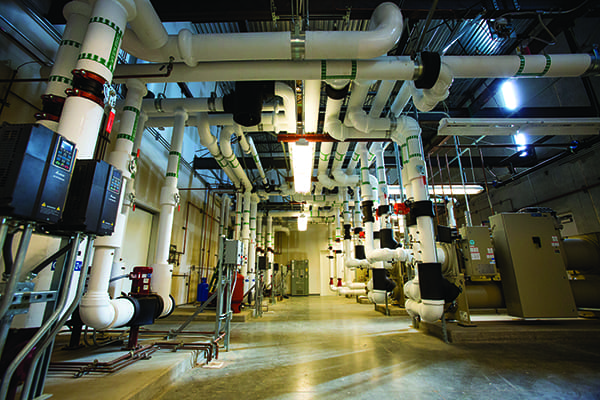Company’s Mission: A Clean Energy Building, and Living Laboratory
The post Company's Mission: A Clean Energy Building, and Living Laboratory appeared first on POWER Magazine.


Embracing sustainability is more than a slogan for Delta Electronics (Americas); it's defined by the company's headquarters building. The site incorporates Delta's own technologies to promote energy efficiency and the production of clean power.
Many companies have a mission statement, words designed to define what the company values, how it operates, and the way it will serve its customers and community. For Delta Electronics (Americas), the U.S.-based arm of Taiwan's Delta Electronics, a nearly 50-year-old global provider of power and thermal management solutions, the mission statement is more than a slogan. It's woven into the fabric of the company's Americas headquarters building in Fremont, California.
The 178,000-square-foot LEED Platinum building incorporates Delta's own energy-efficient solutions to achieve sustainability. (LEED, which stands for Leadership in Energy and Environmental Design, is an internationally recognized green building certification program.) The innovations are many: a solar photovoltaic (PV) system with Delta's high-efficiency solar inverters, along with a ground source heat pump and geothermal system that takes advantage of Fremont's natural warm springs, and supports a bi-directional radiant heating and cooling system, with active chilled beams.
The $68-million building also utilizes Delta's variable frequency drives, which enable speed control of industrial motors in fans, pumps, and other equipment, promoting energy efficiency. The campus also includes 19 of Delta's alternating current electric vehicle (EV) chargers, and there's a 140,000-gallon rainwater harvesting tank, from which water is taken to irrigate the landscape.
Our mission statement is: To provide innovative, clean and energy-efficient solutions for a better tomorrow.' That statement says a lot," Ruth Chao, corporate affairs manager for Delta Electronics (Americas), told POWER. That's an English translation of the original mission statement in Chinese-protect the environment, save energy, love the Earth.' It's telling the company that sustainability matters, that all of these things are embedded in our DNA. It all comes from [company founder] Bruce Cheng."
Chao noted that Cheng, who founded Delta in Taipei, Taiwan, in 1971, valued a focus on environmental issues and sustainable business practices long before it became fashionable, with the company dedicated to manufacturing energy-efficient products.
 |
1. The geothermal heating and cooling system at the Delta Electronics (Americas) headquarters building circulates 12,000 gallons of water through 92 miles of pipes. Courtesy: Delta Electronics (Americas) |
[Cheng] started looking into all these various systems that buildings can incorporate," Chao said, either into our own building, or in schools or other buildings... like incorporating geothermal. I am very, very glad that we were able to install that system." And it's quite the system (Figure 1), circulating 12,000 gallons of water through 92 miles of pipes.
Delta's building has already been honored with several awards for its innovative and energy-saving design. It can now add one more to the list: POWER's Commercial & Industrial Generation award.
Location Key to Building's DesignDelta's Americas headquarters building was designed by J.J. Pan & Associates, a Taiwan-based group, in collaboration with San Francisco-based Korth Sungeri Hagey (KSH) Architects. Nearby Palo Alto-based Vance Brown Builders served as the general contractor.
The building's Fremont location, adjacent to natural wetlands, helped with the design of the innovative geothermal heating and cooling system that reduces the campus' heating, ventilation, and air conditioning (HVAC) energy consumption by 60% compared to traditional systems. The building's 616-kW rooftop PV system currently powers about 70% of the entire facility's annual energy consumption.
| POWER POINTS Winning Attributes
|
A recently installed 506-kW bi-facial carport PV system, combined with Delta's own inverters and energy storage systems, has the campus on pace to achieve net-zero energy consumption in the near future. The building, which can house as many as 500 employees, includes office space, test laboratories, a data center, product showroom, and a 40,000-square-foot warehouse.
We had some challenges trying to put this system together. I was involved with the project, starting in 2010, when we were wanting to build a green' building, and I had never dealt with construction," said Chao, who served as Delta's internal project coordinator. We were able to put together this great team of contractors and consultants. Everything was thought about at the design stage, what the goals were and how to achieve them."
Construction began in September 2013, and Delta employees began moving in two years later.
We had to find the right team that shared our vision, our goals, and could deliver a building that looks like something that would fit our mold," Chao said. It was quite a challenge. It took a joint effort between KSH and J.J. Pan to come up with the design of the building."
A Strong Foundation, From the Ground UpMike Gazzano, the marketing manager for Delta Electronics (Americas), told POWER, We literally designed this building from the ground up, with the geothermal system being one of the first things. Getting the foundation done, the bidirectional system, there are so many systems and so many different technologies running through this building."
The Delta team noted the building takes advantage of geographical advantages in Fremont, which support the responsible production and consumption of energy and water, bio-treatment-as well as occupant awareness/education-without sacrificing occupancy comfort, or building resilience." Some examples include the natural warm springs, ideal for a geothermal system, and a sunny and expansive location, ideal for solar panels.
There also are disadvantages to the site that have been overcome-limited rainfall, leading to the rainwater harvesting system; proximity to protected lands, in this case adjacent wetlands, that led to constructing bioswales for water treatment, and new designs for the geothermal system; and the location in a high-risk earthquake area. The building is built 20% stronger than what the state's earthquake code requires.
The building also was put on higher ground, due to its location in a 100-year flood risk area. Recent additions to the project include a high-efficiency uninterruptible power supply (UPS), and a dedicated air-side economizer, for the data center; a solar carport; and expanded sub-metering.
In addition to the designers, architects, and general contractor, other companies involved in the project include ACCO Engineered Systems (HVAC); Sunbelt Controls (controls); Morrow Meadows (electrical); KDS Plumbing (plumbing); Major Geothermal (geothermal); and Rodda Electric (rooftop solar).
John Walter, the lead KSH architect on the project, told POWER the biggest difference compared to other projects involving his company was in the building's design. There were so many different mechanical systems that went into this building," Walter said. We had 17, 18, 19 months of weekly meetings with the engineers. Everyone had to come to the table to collaborate on this project, to incorporate all these different systems going into the building."
Walter continued: It was everything from the sequence of install, and the way everything works together. It starts with the geothermal loop, which basically goes beneath half the site. It was making sure the installation of the foundations for the electric vehicle charging canopy didn't interfere with the geothermal loop. There are thousands of feet of tubing in our structural slab, and it would be almost impossible to drill through those slabs later without hitting your radiant tubing."
Community InvolvementThe Delta campus has become a showcase for clean energy in Silicon Valley. Delta opens its facility as an interactive and educational opportunity for local high school students, learning about Delta's energy-efficiency solutions, and the importance of sustainability. The company also has offered hands-on workshops, geared toward those looking to pursue careers in the environment and engineering fields.
Our building is a community impact project," Arthur Jen, Delta's project specialist for Corporate Social Responsibility (CSR), told POWER. We get the community involved. We have a lot of visitors, students from high schools and universities, we do a lot of showroom tours. We also have a CSR program, which started in the U.S. last year. With our Learn It Together, Do It Yourself (LIT DIY)' program, we give students the opportunity to learn from professionals, and these are all free programs."
Jen noted the building is, in effect, a working laboratory. We talk about energy auditing, about market exposure, and the Center for the Built Environment (CBE) at [the University of California, Berkeley] is using our building as a research project [for master's and doctoral students] to see how efficient it is, and answer the question: How do we increase occupancy comfort without increasing energy load?' "
The Delta team said its building receives visitors from the government, business, and nonprofit sectors, with the company's goal to offer the headquarters as a prototype and model for green buildings across the globe.
Green buildings are never-really-complete," Chao said. That is because they require continuous maintenance and improvements to ensure resilience. That being said, construction of the Delta Americas headquarters required an enormous amount of dedication from the project team, who was firmly committed to meeting and exceeding all of Delta's sustainability objectives. We hope this project serves as a beacon of sustainable design in Silicon Valley, California, and the broader community, as we all seek to build a greener future together."
-Darrell Proctor is associate editor for POWER (@DarrellProctor1, @POWERmagazine).
The post Company's Mission: A Clean Energy Building, and Living Laboratory appeared first on POWER Magazine.
 Awareness: The Delta headquarters utilizes green technologies, and is designed to showcase them to the public to bring awareness about the importance of sustainability. The building features an oversized canopy-visibly clad in photovoltaic panels-to showcase the energy-harvesting elements.
Awareness: The Delta headquarters utilizes green technologies, and is designed to showcase them to the public to bring awareness about the importance of sustainability. The building features an oversized canopy-visibly clad in photovoltaic panels-to showcase the energy-harvesting elements.